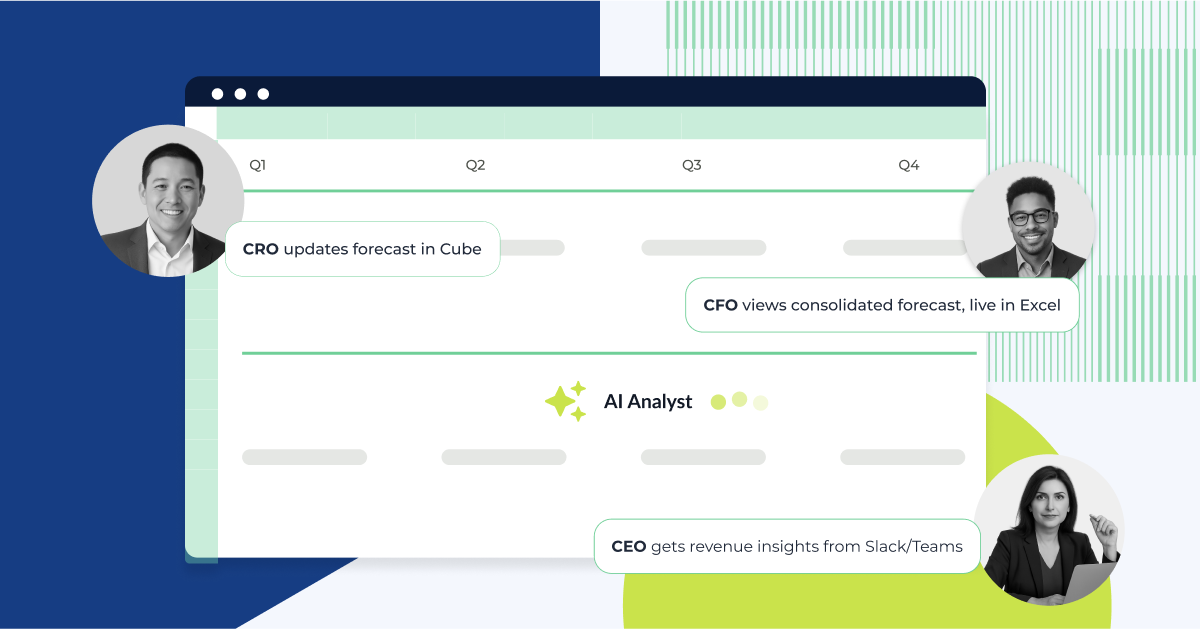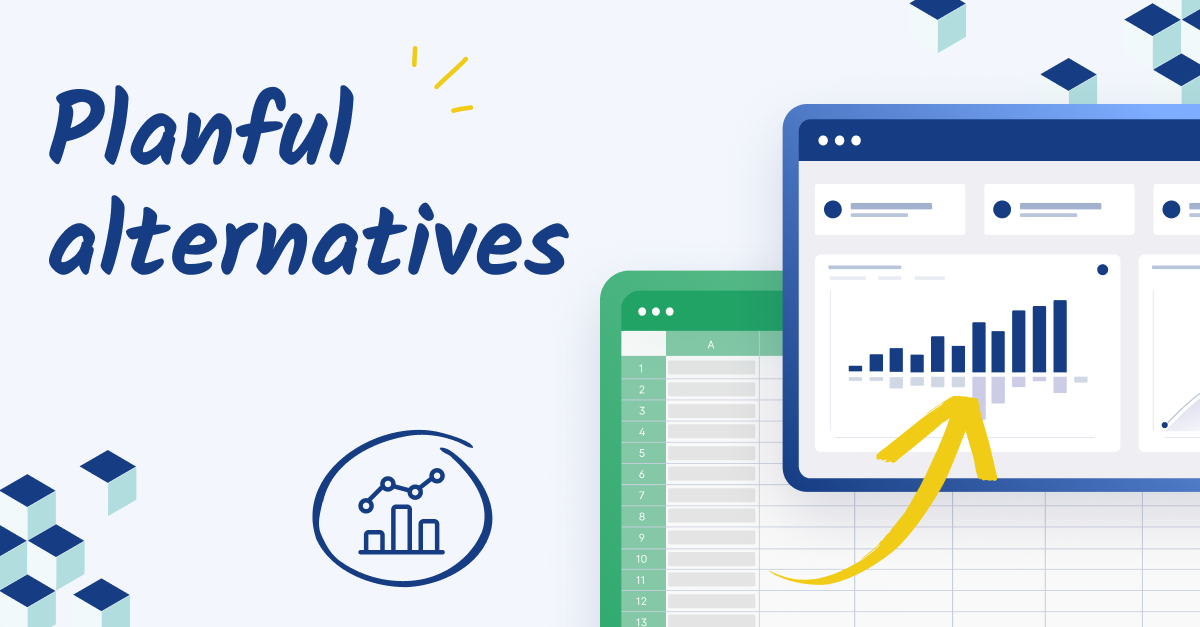What is strategic planning in finance?
Strategic financial planning is the process of determining how a business financially manages its assets to achieve ROI and growth goals. Strategic planning in finance is sometimes called strategic financial management. It falls under the purview of the CFO and the FP&A team.
The first step to effective strategic planning in finance is building a solid, forward-looking financial plan that ties into the company’s goals. This means analyzing growth targets, reviewing past performance, and creating models to predict future financial scenarios. Effective planning expands the role of the CFO or FP&A team from managing current finances to shaping the company’s financial trajectory.
Long-term planning helps spot opportunities for growth, plan smart investments, and keep everyone prepared for risks. Finance teams can step up to create strategies that protect the company’s finances and drive its future success by looking at where the company is today, what’s happening in the market, and where it wants to go.

What is strategic planning software?
Strategic planning software helps organizations analyze their financial situation, develop actionable plans, and track progress against their goals. It helps reach the goal of strategic management: to ensure an excellent ROI for the business and its stakeholders in the future.
The finance sector uses strategic planning software to:
- Gain insight into financial markets
- Develop and execute successful strategies
- Analyze historical market trends and use predictive analytics to forecast future movements.
Strategic planning software helps teams determine how much risk to take for certain investments and how to manage portfolios for the best return. By leveraging this technology, finance professionals can optimize their portfolios for long-term growth and maximize shareholder value.
Of course, strategic planning solutions should also help you improve your strategic planning process.
Key features of strategic planning software
Strategic planning software offers a range of features designed to bring greater efficiency and effectiveness to financial planning and corporate management.
1. Project management
Strategic planning software can help organize and track team activities around specific projects. It facilitates team collaboration by providing a centralized communication and task assignment hub.
For example, project milestone tracking can help ensure tasks are completed on time and the project runs according to schedule. Other features like Gantt charts help users visualize project lifecycles and timelines.
2. Data tracking, analysis, and reporting
Strategic planning software solutions offer a range of features that enable businesses to track their progress, uncover valuable insights, and communicate their results to stakeholders.
- Data tracking allows users to follow the progress of their goals and objectives, identify trends in performance, and access relevant data.
- Analytical capabilities enable users to quickly and automatically compare metrics across different periods or areas of the business.
- Reporting capabilities provide comprehensive yet concise documentation that presents key performance indicators in an easy-to-read format.
3. Strategy development
Strategy development is a crucial aspect of running a successful business. It involves creating and implementing plans to achieve specific goals and objectives. A good strategic planning solution should:
- Provide users with the tools they need to develop actionable strategies tailored to their needs. This may include setting objectives and milestones, creating an actionable timeline, assigning tasks to team members, and creating a budget.
- Allow users to monitor progress and adjust their strategies as needed.
- Provides users with scenario analysis, sensitivity analysis, and other analytic templates that enable businesses to evaluate different scenarios and identify potential risks and opportunities.
Some corporate planning software programs offer predictive analytics capabilities that help businesses understand how external factors may influence their strategies.
Businesses can forecast, budget, and plan accordingly using industry trends, economic indicators, and customer sentiment surveys.

Benefits of using strategic financial planning software
The advantages of using strategic planning software include the following:
Strong collaboration
Strategic planning software provides users with a single source of truth, supporting quicker decision-making and easier collaboration. It keeps everyone on the same page, whether they’re in the same office or working remotely across the globe.
The software ensures that everyone is working toward the same objectives by aligning teams with a unified financial plan tied to the company’s goals. Accessible, updated documentation also helps teams identify potential risks, troubleshoot issues, and prepare for growth opportunities together.
Improved decision making
Strategic planning is a disciplined effort that produces fundamental decisions and actions to shape and guide an organization. FP&A analysts can use the software for predictive driver-based and multi-scenario planning to evaluate the company’s current standing and forecast its future.
With these tools, executives can outline their financial objectives, assess market risks, and create forward-looking plans that safeguard the company’s financial health. Once the plan is in place, the software makes tracking progress and making necessary adjustments simple and intuitive.
Better visibility
Advanced analytics and reporting capabilities provide a holistic view of company performance. This enhanced visibility empowers leaders to assess the financial trajectory and align plans with strategic goals. Users across all departments can see real-time metrics and understand the financial impact of their actions.
The software’s easy-to-read tables and graphs make complex data accessible and the real-time insights ensure businesses can respond quickly to market changes or risks. This reduces planning errors and helps identify growth opportunities to improve strategies for better outcomes.
Better strategic execution
Continuous planning also becomes more straightforward, as strategic management software makes planning processes simpler and easier to follow. So the cost of creating and refining strategic plans goes down.
With access to more performance data, businesses can use these insights to guide strategic initiatives, improve project portfolio management, and adapt their approach as needed. This proactive planning helps finance teams move from managing the present to shaping the company’s future trajectory.
The best strategic planning software solutions for CFOs
Some of the best software used for strategic financial planning include:
1. Cube

What it is: FP&A software for demand forecasting and financial planning
Who it’s for: Finance teams who want to automate forecasting, manage budgets, and plan within Excel and Google Sheets
Cube is the first spreadsheet-native FP&A platform that empowers finance teams to plan faster, more nimbly, and more scalably without changing how they work. The cloud-based FP&A software helps finance teams work more effectively by collecting and centralizing data into a single source of truth. This empowers teams to create plans and reports based on that trusted data in the spreadsheets they know and love.
Cube transforms FP&A with a spreadsheet-native platform that offers fast, flexible, and scalable financial analysis for continuous collaboration and insights. Many high-growth companies (like BlueWind Medical and Edge Fitness Clubs) use Cube for all their FP&A needs.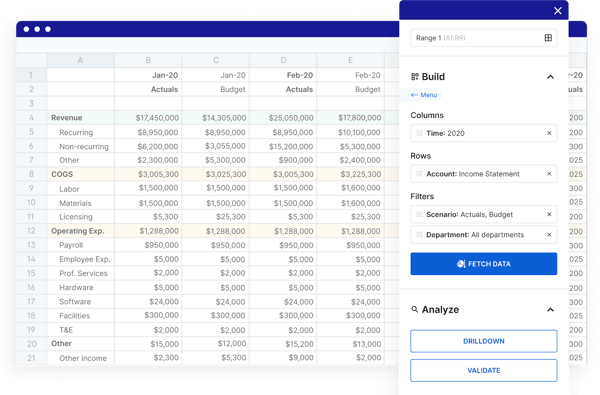
Perhaps even more importantly, Cube was founded by a former CFO. The problems and use cases of FP&A have been baked into Cube since its inception.
FP&A teams already know and love spreadsheets. Cube simplifies many of the headaches of the often challenging planning process—like collecting actuals from other departments or checking and verifying that your numbers are correct—and lets teams turn their complicated budgeting process into a lean operation.
Key features:
- Forecasting powered by AI: Generates forecasts based on past and current financial data to support better decision-making.
- Proactive variance analysis: Detects anomalies and highlights deviations from expected financial performance for quick resolution.
- Automated data validation: Identifies inconsistencies across datasets to ensure accuracy without manual checks.
- Multi-scenario analysis: Models how changes to key assumptions seamlessly affect overall outputs.
- Endless integrations: Offers integrations for spreadsheets (Google and Excel), accounting and finance, HR, ATS, billing and operations, sales and marketing, and business intelligence.
- Customizable dashboards: Lets you build and share customizable dashboards.
- Native Excel and Google Sheets integration: Works bi-directionally with any spreadsheet for seamless compatibility.
- Multi-currency support: Evaluates financials in both local and reporting currencies.
- User-based controls: Provides user controls, validations, and an audit trail to ensure the correct data goes to the right people at the right time.
- Centralized formulas and KPIs: Stores all calculations in a central location, managed from a single source of truth.
- Drilldown and audit trail: Lets you view the transactions and history behind a single data cell with just one click.
➡️ See all of our features here.
%20(1)%20(1).png?width=600&height=362&name=Big%20image_Howcubeworks_V2%20(4)%20(1)%20(1).png)
Pros:
- Integrates natively with all versions of Excel and Google Sheets.
- Makes onboarding easy for new employees and users by being intuitive for spreadsheet users.
- Offers simple formulas for creating reports to make calculations and processes easy to understand.
- Automates data consolidation and reporting to save time and reduce errors.
- Provides powerful reporting and KPI tracking for smarter business decisions.
- Integrates with dozens of applications, including accounting, HR, and CRM systems.
- Includes free, ongoing customer support to keep you on track and within budget.
Cons:
- Cube works best for mid-sized and commercial businesses–it’s not a personal finance app.
- Cube is built for finance professionals and is not a solution for learning FP&A for the first time.
- Pricing (below) is not designed for pre-series A startups.
Pricing: Cube offers custom pricing and plans starting at $2,000/month.
Best for: Mid-size and enterprise FP&A teams looking to save time and grow. Cube also works for hyper-growth SMBs who want a solution that will scale with their organization's complexity.
Curious to see if Cube is a fit for your organization? Book your demo now.

2. Anaplan
.png?width=150&height=33&name=Anaplan_logo%20(1).png)
What it is: Planning software for forecasting and what-if scenarios
Who it’s for: Finance teams who need scenario planning and collaboration tools
Anaplan is a cloud-based strategic planning software that helps businesses plan and model their operations. The platform provides various tools and features to support these functions, enabling users to create, manage, and share their plans and forecasts.
Anaplan's proprietary hyperblock technology enables businesses to build what-if scenarios. It also provides an application platform that enables organizations to build and customize their planning applications.
The App Hub features pre-constructed apps for sales, operations, finance, human resources, and others and a custom app module.
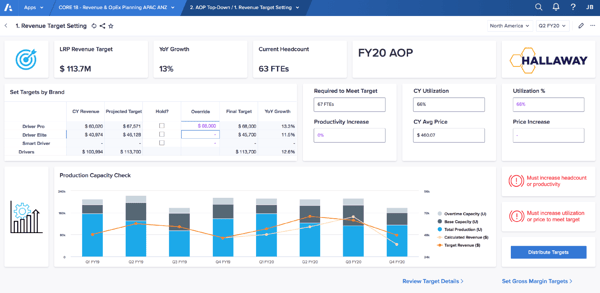
[Source]
Key features:
- Data synchronization: Automatically syncs data across platforms like ERP systems and spreadsheets. This eliminates the need to manually update files whenever new transactions or changes occur.
- Predictive analytics: Uses AI to analyze historical data and forecast future trends. For example, it can identify patterns in expenses or predict revenue fluctuations based on past performance.
- Interactive dashboards: Provides dashboards that display key metrics like cash flow or expenses in real time. These dashboards let users view financial trends and compare metrics across different periods.
- Inter-platform integrations: Connects with tools like accounting software, HR platforms, and CRMs. This allows all financial data to flow into one centralized system.
Anaplan pricing: Pricing is not publicly available
Explore the top Anaplan competitors.
3. Workday Adaptive Planning

What it is: Planning software for financial modeling and scenario planning
Who it’s for: Finance teams managing complex planning needs with predictive analytics and real-time data
Workday Adaptive Planning is a strategic planning software that provides modeling, analytics, and cloud applications for businesses and organizations of all sizes. Workday Adaptive Planning is designed to be similar to Excel, and the core function includes budgeting, forecasting, reporting, dashboards, and financial modeling.
Workday Adaptive Planning comes with a network of global value-added resellers (VARs) that offer training and support services for each transaction.
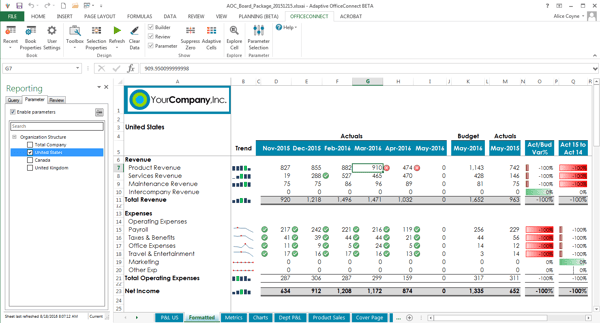
[Source]
Key features:
- Budgeting: Provides tools to create detailed budgets based on historical financial data. This allows users to allocate resources and plan expenditures for upcoming periods.
- Forecasting data analysis: Uses data models to project future financial outcomes. For example, it can predict revenue or expenses based on past trends and changing market conditions.
- Collaboration: Includes features like shared workspaces or comment tracking that let multiple team members work on financial plans simultaneously. This ensures everyone can contribute to budgeting in the same file.
- Real-time updates: Automatically updates data as new information is added from connected systems. This ensures users are always working with the most current financial figures.
Workday Adaptive Planning pricing: Pricing is not publicly available.
Read our comparison of Anaplan vs Adaptive vs Planful vs Vena vs Datarails vs Cube.
4. NetSuite

What it is: Business management software for financial and operational planning
Who it’s for: Operations teams who need a unified platform to manage budgets, inventory, and forecasting
NetSuite is an integrated cloud-based business management software that offers various features spanning ERP, financials, commerce, inventory management, HR, PSA, supply chain management, and CRM. NetSuite provides businesses with automation and real-time operational and financial performance analysis. The platform’s strategic planning module helps businesses create models of long-term strategies that include financial assumptions, cash flow analysis, and resource allocations.
The software allows users to set up scenarios for testing different strategies before executing them. It enables companies to benchmark performance and compares results against competitors.
.png?width=594&height=348&name=6-Accounting-Software-General-Ledger-1080x600px%20(1).png)
Key features:
- Workflow capability: Allows users to create and manage workflows for tasks like approvals and reporting. This ensures that financial processes follow a consistent sequence every time.
- Data import and export tools: Supports importing and exporting data between the platform and external tools like ERP systems or spreadsheets. This feature enables the transferring of large datasets without manual re-entry.
- Financial statements: Generates reports like balance sheets, income statements, and cash flow summaries. These documents provide a clear overview of a company’s financial health for decision-making.
- Audit trail: Tracks all changes made within the system, including who made them and when. This creates a detailed history of transactions and updates.
- AP automation: Automates accounts payable processes, such as invoice matching, approval routing, and payment scheduling. This streamlines vendor payments and reduces the risk of late fees.
NetSuite pricing: Pricing is not publicly available
Read our NetSuite vs Quickbooks comparison.
Did you know?
NetSuite and Cube work together. You can use NetSuite as your ERP solution and connect your data, through Cube, into Excel or Google Sheets, where you can do much of your strategic planning.
The Google Sheets integration is key here, as it makes your strategic planning and progress tracking collaborative and shareable. Everybody can always have access to the most recent data AND you can work in a highly cooperative environment. It's a win-win.

5. Jedox
.jpeg?width=100&height=100&name=jedox-logo%20(1).jpeg)
What it is: Planning software for financial performance management and budgeting
Who it’s for: FP&A teams who need customizable tools for budgeting, forecasting, and integrating data across systems
Jedox is a planning and performance management platform for finance, sales, and operations. Jedox uses artificial intelligence to offer integrated business planning.
Jedox enables users to create financial models, budgeting solutions, and forecasting models. It was designed to help organizations assess performance and make decisions on how to optimize operations.
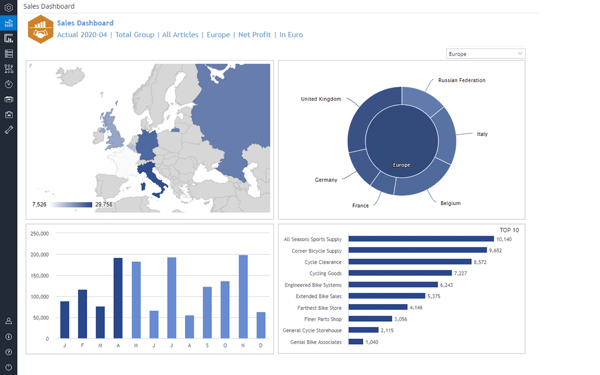
Key features:
- Forecasting: Provides tools to create projections for future financial performance based on historical data and trends. This helps users anticipate revenue, expenses, and other financial metrics.
- Real-time data updates: Automatically updates financial data across the platform as new transactions occur. This ensures users always work with the latest figures without needing to refresh or re-enter information.
- Data visualization: Displays financial insights using charts, graphs, and dashboards. These visual tools make it easier to identify trends, compare metrics, and present data to stakeholders.
- Cash flow planning: Helps track and predict cash inflows and outflows over time. This ensures businesses can identify potential shortfalls or surpluses to manage liquidity.
Jedox pricing: Pricing is not publicly available
6. Planful

What it is: FP&A software for budgeting, forecasting, and financial reporting
Who it’s for: Finance teams who want to automate workflows and visualize forecasts
Planful, formerly Host Analytics, is one of the market's best-established FP&A platforms. Planful, as the name suggests, specializes in helping you plan better, whether in strategy, budgeting, or forecasting. It offers AI-powered features that automate daily finance tasks and provides real-time data insights through dashboards. CFOs can use Planful to make current financial decisions based on potential future outcomes.

Key features:
- Excel reporting and integrations: Connects directly with Excel to import, export, and analyze data within spreadsheets. This allows teams to use familiar tools while maintaining up-to-date financial information.
- Data visualizations: Transforms financial data into visual formats. These visuals help teams communicate insights with stakeholders.
- Personalized dashboards: Allows users to customize dashboards to display the metrics and reports most relevant to their work. This ensures quick access to key insights for their departments.
- Forecasting: Provides tools to project future financial outcomes. This helps teams prepare for changes in revenue or expenses.
- What-if scenarios: Enables users to model potential financial outcomes based on hypothetical changes to variables like costs, revenue, or external factors. This feature helps organizations evaluate risks and plan more effectively.
Planful pricing: Pricing is not publicly available

7. Board

What it is: Planning software for financial modeling and predictive analytics
Who it’s for: Finance teams who need planning, simulation, and analytics
Board is a strategic planning software with predictive analytics, comprehensive financial modeling, and advanced simulation capabilities. The platform provides users with an intuitive user interface and workflow, enabling them to define goals, set objectives, analyze data, track progress, and make necessary changes.
Board uses advanced machine learning algorithms to help companies forecast future outcomes based on past performance and current trends.
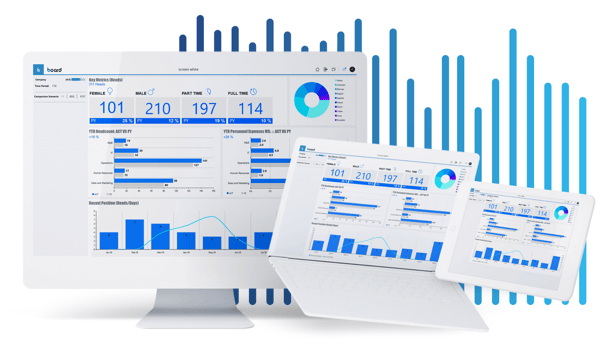
Key features:
- Data column filtering, discovery, and visualization: Lets users filter and sort large datasets to focus on specific categories. For example, finance teams can isolate data for a particular department, visualize it in graphs, and uncover trends at a granular level.
- Auto-modeling: Automatically creates financial models based on inputted data. This feature might generate a complete revenue projection without requiring users to build formulas from scratch.
- Predictive analysis: Uses historical data and AI to predict future outcomes like revenue growth or cost fluctuations. For example, a CFO could see projected sales dips in a specific quarter and plan adjustments accordingly.
- Report generation: Automatically compiles financial data into professional reports like income statements or cash flow summaries. These reports can be shared with stakeholders or used internally for decision-making.
- Simple dashboards: Provides easy-to-navigate dashboards that display key metrics or benchmarks. This gives users a snapshot of financial health without needing to dig through spreadsheets.
Board pricing: Pricing is not publicly available
8. OneStream

What it is: Corporate performance management software for financial consolidation, planning, and reporting
Who it’s for: Teams who need to centralize budgets, forecasts, and reconciliation from multiple data sources
OneStream is a CPM 2.0 solution that offers financial consolidation, planning, reporting, analytics, and financial data quality services to medium and large-sized companies.
OneStream is used to streamline financial processes, replace outdated legacy applications, and decrease the overall cost of ownership for financial systems. It allows teams to spend less time dealing with data integration and system maintenance.
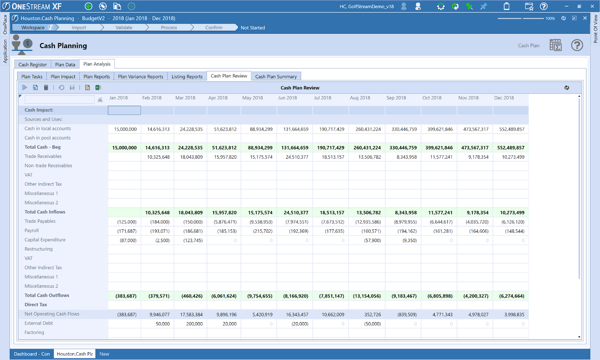
Key features:
- Data integration, reporting, and transformation: Combines data from multiple sources, organizes it into usable formats, and generates detailed reports. CFOs can consolidate information from ERP systems and spreadsheets to create a single financial summary.
- BI dashboarding: Offers business intelligence dashboards to visualize financial data in real-time. CFOs can use these dashboards to track KPIs like cash flow or department spending.
- Marketplace solutions like Task Scheduler and Security Audit: Provides tools for automating routine processes like scheduling tasks or running system audits.
- Budgeting, forecasting, and reconciliation: Helps create budgets, forecast financial scenarios, and make sure accounts are accurate. CFOS can adjust budgets based on current performance and reconcile discrepancies in real time.
OneStream pricing: Pricing is not publicly available
9. Cascade
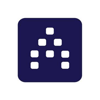
What it is: Planning software for strategy mapping and goal tracking
Who it’s for: Teams looking to review and align KPIs with long-term growth goals
Cascade is a cloud-based strategic planning software solution to help businesses develop long-term growth plans. It focuses on critical areas of the planning process, such as goal setting, budgeting, monitoring progress, and managing resources.
Cascade also includes features for collaboration, analytics, reporting, and visualizing data. The software's analytic capabilities enable businesses to review past performance and adjust future action plans accordingly.
It’s designed to be used by team members of any level and can integrate with other corporate systems.
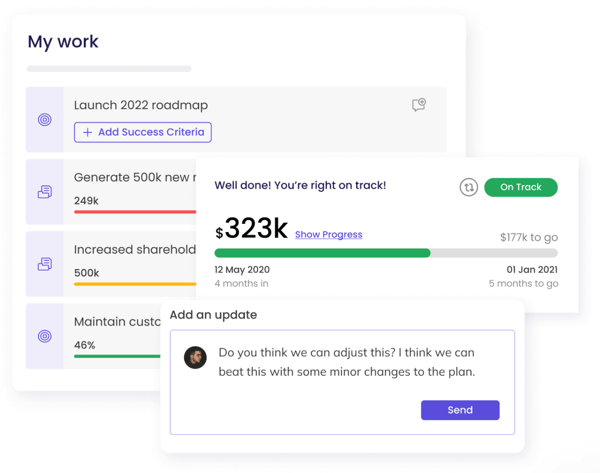
Key features:
- Strategy mapping and modeling: Provides tools to create visual strategy maps and develop models for achieving business goals. For example, CFOs can model the financial impact of launching a new product.
- Defines and monitors objectives and key results: Helps set measurable objectives and track progress toward achieving them. CFOs can monitor sales growth targets and see whether they are meeting monthly goals.
- Monitor the progress of strategy-related activities: Tracks the completion status of projects and initiatives tied to strategic goals. This ensures teams stay aligned with timelines and deliverables.
- Departmental KPI reporting: Generates reports that display key performance indicators for individual departments. For example, finance teams might track expense ratios, while marketing monitors campaign ROI.
Cascade pricing:
- Cascade Free: $0
- Essentials: Pricing is not publicly available
- Enterprise: Pricing is not publicly available

10. Jirav

What it is: FP&A software for financial modeling
Who it’s for: CFOs and finance teams creating scenario plans and sharing financial reports
Jirav is a driver-based planning platform with features for CFOs to customize reporting and planning. Users can create KPI packages that summarize the current state of their financial health to stakeholders. They can also create new scenario plans based on key business drivers.
Key features:
- Driver-based planning platform: Enables planning based on key business drivers like revenue growth or cost per unit. CFOs can adjust variables like sales volume to see how changes impact overall financial outcomes.
- Templated and custom reporting: Offers pre-built templates for common reports and the ability to create customized ones.
- Shareable dashboards: Provides dashboards that can be shared with team members or stakeholders. This feature ensures everyone has access to the same financial insights.

[Source]
Jirav pricing
Jirav has two pricing tiers:
- Industry Safari: $20,000+
- Strategy Safari: Pricing is not publicly available
11. Sage Intacct

What it is: Financial management software for automating accounting processes and gaining operational insights
Who it’s for: Finance teams managing accounting tasks and multi-entity consolidations
Sage Intacct is a cloud-based financial management and accounting software for small to midsize organizations. It helps businesses automate critical financial processes and gain insights into their operational performance. It's tailored to accommodate the needs of each accountancy firm and comes with a comprehensive suite of functionality that will streamline core financials.
Sage Intacct provides core accounting applications like the general ledger, accounts payable and receivable, cash management, and order management. It supports functionality for built-in dashboards, real-time reporting, time and expense management, project accounting, revenue management, and global consolidations for multiple entities.
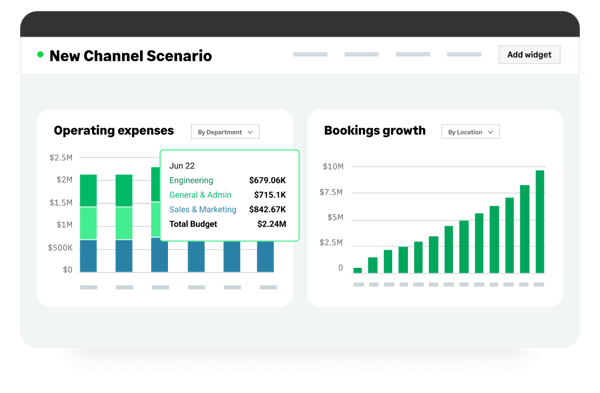
Key features:
- Audit trail: Tracks every action taken within the system like edits of financial data or approvals. This provides a complete history of changes for accountability and compliance purposes.
- Invoice customization: Allows businesses to customize invoices with their branding or payment terms details. For example, CFOS can add their company logo or specify due dates directly on the invoice template.
- AP automation: Automates accounts payable processes like invoice matching and vendor payments. This ensures payments are processed on time without manual intervention.
- Performance and reliability: Users can rely on consistent system performance to handle large data sets and critical financial operations.
Sage Intacct Pricing: Pricing is not publicly available
Bonus: Top AI tools for strategic planning
Ai tools can help CFOs by automating tedious tasks and uncovering data anomalies that could take long amounts of time to manually discover.
- Cube simplifies financial planning, reporting, and analysis for businesses. Their AI powers forecasting, variance analysis, and data validation to save time and reduce manual effort for finance teams. Jumpstart planning tasks with proposed forecasts, highlight variances, and flag inconsistencies automatically so your data stays accurate and your team can focus on strategy.
- ClearPoint Strategy integrates project tracking with KPI reporting to allow one view of the truth in your organization.
- Notion AI writes, spell checks, and summarizes key points, lengthy text, and databases in existing strategic planning notes.
- Pigment uses machine learning to forecast the futures of your business.
Selecting the right strategic planning software
The right strategic planning software empowers organizations to identify growth opportunities, mitigate risks, and improve collaboration across teams. Selecting a solution that supports long-term planning and adapts to your evolving needs can turn your finance function into a strategic driver for success. Let’s explore how you can select the right software to shape your organization’s financial trajectory.
Assess integration and compatibility
Verify whether the software integrates seamlessly with existing systems like ERPs, CRMs, or accounting platforms. For example, a system that syncs directly with your ERP can automatically pull in financial data and save your team from wasting time on manual entry. Check compatibility with your IT team to choose software that works smoothly with your tech stack. A lack of integration can lead to unnecessary downtime and costly workarounds later.
Involve key stakeholders
Involve key stakeholders like finance, operations, and IT teams early in the selection process. Hosting workshops or surveys can help uncover specific departmental needs and pain points the software must address. Collaboration ensures buy-in from all teams and reduces resistance to adoption later. This level of teamwork helps align software capabilities with both immediate and long-term business goals.
Analyze cost vs. benefit
Perform a detailed cost-benefit analysis to understand the value the software will bring to your organization. Consider monthly subscription fees, licensing fees on the investment end, and the savings from improved efficiency and reduced errors on the returns end.
For example, a platform that automates manual workflows might save hours of labor each week, translating into thousands of dollars in saved time. Balancing direct costs with indirect benefits like scalability and improved decision-making will lead to a higher ROI.
Evaluate software features
Focus on features that address your organization’s unique needs like real-time reporting, customizable dashboards, or scenario planning tools. For example, if your business struggles with visualizing KPIs, prioritize software with easy-to-understand data visualization capabilities.
Ensure the platform can handle your data volume and complexity, especially if you work across multiple departments or regions. Avoid overwhelming your team with unnecessary features that don’t align with your goals.
Make the final choice
Weigh stakeholder feedback, cost-benefit analysis, and your strategic objectives to make an informed decision. For instance, if scalability is a key point, choose a vendor with a track record of supporting businesses through growth phases. Consider vendor reputation and customer support just in case problems occur down the line.
Ensure your final software choice aligns with both current needs and future plans to maximize long-term value.
Choose the best strategic planning software
Now that you know all about the best strategic planning software, you’re ready to choose the right solution for your business. The right platform helps CFOs save time, prioritize resources, and adapt to unexpected market changes. It enables your team to track performance metrics, adjust forecasts, and create financial plans that align with your company’s goals.
Focus on tools that address your biggest challenges first. Investing in software that simplifies workflows and supports growth allows you to make critical decisions quickly and confidently.
For CFOs looking for a strategic planning software that offers seamless integration with Excel and Google Sheets, automated data consolidation, and real-time insights, consider Cube. Cube helps CFOs and finance teams streamline daily workflows, model scenarios, and gain actionable insights—all within the spreadsheets they already use.
Book a free demo with Cube today.



.png)









.png)

![Best strategic planning software for CFOs [2025 review]](https://www.cubesoftware.com/hubfs/Frame%2014-1.png)


%20(1)%20(1).png?width=600&height=362&name=Big%20image_Howcubeworks_V2%20(4)%20(1)%20(1).png)




.png?width=594&height=348&name=6-Accounting-Software-General-Ledger-1080x600px%20(1).png)
.jpeg?width=100&height=100&name=jedox-logo%20(1).jpeg)









.png)
